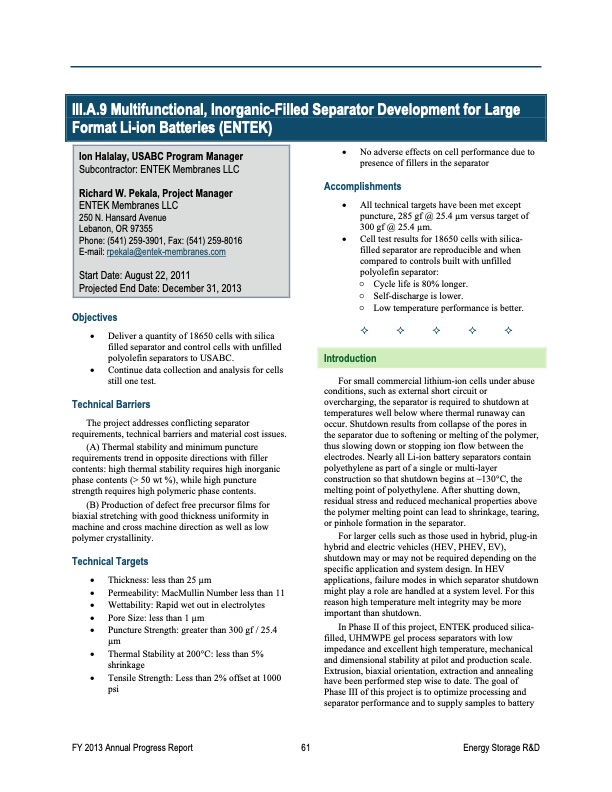
PDF Publication Title:
Text from PDF Page: 039
III.A.9 Multifunctional, Inorganic-Filled Separator Development for Large Format Li-ion Batteries (ENTEK) Ion Halalay, USABC Program Manager Subcontractor: ENTEK Membranes LLC Richard W. Pekala, Project Manager ENTEK Membranes LLC 250 N. Hansard Avenue Lebanon, OR 97355 Phone: (541) 259-3901, Fax: (541) 259-8016 E-mail: rpekala@entek-membranes.com Start Date: August 22, 2011 Projected End Date: December 31, 2013 Objectives Deliver a quantity of 18650 cells with silica filled separator and control cells with unfilled polyolefin separators to USABC. Continue data collection and analysis for cells still one test. Technical Barriers The project addresses conflicting separator requirements, technical barriers and material cost issues. (A) Thermal stability and minimum puncture requirements trend in opposite directions with filler contents: high thermal stability requires high inorganic phase contents (> 50 wt %), while high puncture strength requires high polymeric phase contents. (B) Production of defect free precursor films for biaxial stretching with good thickness uniformity in machine and cross machine direction as well as low polymer crystallinity. Technical Targets Thickness: less than 25 μm Permeability: MacMullin Number less than 11 Wettability: Rapid wet out in electrolytes Pore Size: less than 1 μm Puncture Strength: greater than 300 gf / 25.4 μm Thermal Stability at 200°C: less than 5% shrinkage Tensile Strength: Less than 2% offset at 1000 psi No adverse effects on cell performance due to presence of fillers in the separator Accomplishments All technical targets have been met except puncture, 285 gf @ 25.4 μm versus target of 300 gf @ 25.4 μm. Cell test results for 18650 cells with silica- filled separator are reproducible and when compared to controls built with unfilled polyolefin separator: o Cyclelifeis80%longer. o Self-dischargeislower. o Lowtemperatureperformanceisbetter. Introduction For small commercial lithium-ion cells under abuse conditions, such as external short circuit or overcharging, the separator is required to shutdown at temperatures well below where thermal runaway can occur. Shutdown results from collapse of the pores in the separator due to softening or melting of the polymer, thus slowing down or stopping ion flow between the electrodes. Nearly all Li-ion battery separators contain polyethylene as part of a single or multi-layer construction so that shutdown begins at ~130°C, the melting point of polyethylene. After shutting down, residual stress and reduced mechanical properties above the polymer melting point can lead to shrinkage, tearing, or pinhole formation in the separator. For larger cells such as those used in hybrid, plug-in hybrid and electric vehicles (HEV, PHEV, EV), shutdown may or may not be required depending on the specific application and system design. In HEV applications, failure modes in which separator shutdown might play a role are handled at a system level. For this reason high temperature melt integrity may be more important than shutdown. In Phase II of this project, ENTEK produced silica- filled, UHMWPE gel process separators with low impedance and excellent high temperature, mechanical and dimensional stability at pilot and production scale. Extrusion, biaxial orientation, extraction and annealing have been performed step wise to date. The goal of Phase III of this project is to optimize processing and separator performance and to supply samples to battery FY 2013 Annual Progress Report 61 Energy Storage R&DPDF Image | Advanced Battery Development

PDF Search Title:
Advanced Battery DevelopmentOriginal File Name Searched:
APR13_Energy_Storage_d_III_Adv_Battery_Dev_0.pdfDIY PDF Search: Google It | Yahoo | Bing
Turbine and System Plans CAD CAM: Special for this month, any plans are $10,000 for complete Cad/Cam blueprints. License is for one build. Try before you buy a production license. More Info
Waste Heat Power Technology: Organic Rankine Cycle uses waste heat to make electricity, shaft horsepower and cooling. More Info
All Turbine and System Products: Infinity Turbine ORD systems, turbine generator sets, build plans and more to use your waste heat from 30C to 100C. More Info
CO2 Phase Change Demonstrator: CO2 goes supercritical at 30 C. This is a experimental platform which you can use to demonstrate phase change with low heat. Includes integration area for small CO2 turbine, static generator, and more. This can also be used for a GTL Gas to Liquids experimental platform. More Info
Introducing the Infinity Turbine Products Infinity Turbine develops and builds systems for making power from waste heat. It also is working on innovative strategies for storing, making, and deploying energy. More Info
Need Strategy? Use our Consulting and analyst services Infinity Turbine LLC is pleased to announce its consulting and analyst services. We have worked in the renewable energy industry as a researcher, developing sales and markets, along with may inventions and innovations. More Info
Made in USA with Global Energy Millennial Web Engine These pages were made with the Global Energy Web PDF Engine using Filemaker (Claris) software.
Sand Battery Sand and Paraffin for TES Thermo Energy Storage More Info
| CONTACT TEL: 608-238-6001 Email: greg@infinityturbine.com | RSS | AMP |